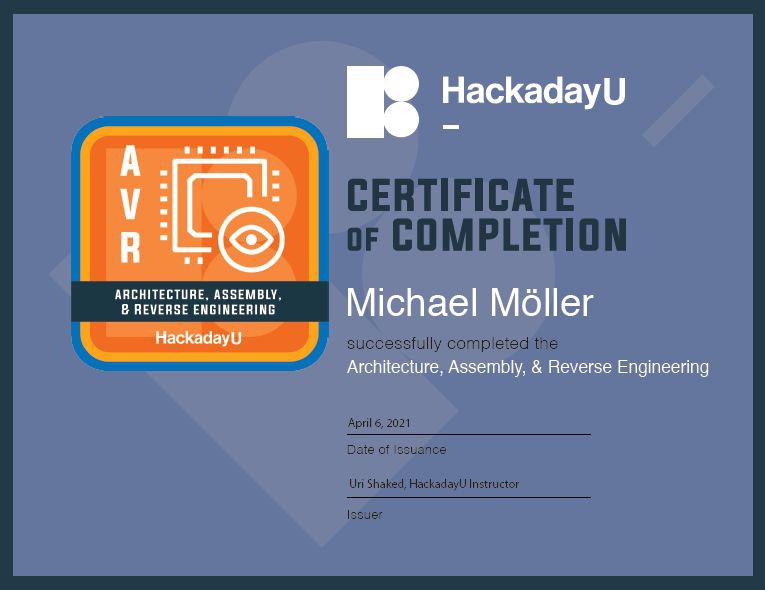-
Certificate of Completion
04/06/2021 at 14:28 • 0 commentsIn some ways, not worth the electrons used to store it, but I am still proud enough to post it anyhow. It was a great course !
![]()
My Projects
Projects I Contribute To
My Pages
Things I've Built
MasterDial
A rotary telephone dial - enter a 4 digit number and the 4 LEDs will show how close you are to the secret code. (same rules as in the old board game MasterMind) https://labitat.dk/wiki/MasterMind_Dial
Sand Mandala Plotter
Drizzling colored sand on a table, like Tibetan Buddhist ritual sand mandalas, except it still is very coarse. https://labitat.dk/wiki/Sand_Mandala_Plotter
Projects I Like & Follow
Share this profile
ShareBits
Become a Hackaday.io Member
Create an account to leave a comment. Already have an account? Log In.
Hi Michael,
I have posted a LogiSim for a 4 bir SubLEq if your interested. It is as simple as I can make it.
https://hackaday.io/project/181600-subleq-revisted
Worth a look if your still interested in SubLEq.
Regards AlanX
Hi AlanX, thanks for the reference. Yes I am still interested. Had the SubLeq board I have (80% complete) at a Hacker meetup and a few people were very interested, and I have not shelved the project, it has just stood still. I started making an animation of sorts of the block diagram to explain it to people. After I have "rebooted" my mancave/workshop (it's horribly overfilled at the moment) work will continue.
Incidentally my SubLeq is 8 bit (by nature of SubLeq you cant have different address and data widths...(?))
Hi Michael,
Yes, you can have different address/data width. You can use paging if the address width is wider. If the data width is wider or wider than the available memory, then the high bits can be used for opcodes. Usually, just the high bit, it is used to avoid the self-modifying code (something that basically does my head in each time I look at it) that is necessary for "pointer/indirect" move or "stack" type operations.
I used virtual ROM/RAM for one of my 8 bit TTA CPUs:
* RAM 0xC0-0xFF (Fixed RAM Page 0xFF: Used for registers/global data etc)
* RAM 0x80-0xB7 (User RAM Page 0x00-0xFE: Used for program/data etc)
* ROM 0x00-0x77 (User ROM Page 0x00-0xFF: Used for boot/IO/system etc)
The page registers are memory mapped. I could therefore access 16kb RAM and 32kb ROM but paging is messy.
Counting chips my version has ~15 chips for the 4 bit version and there after ~10 chips per 4 bits. Still, I am not building this one as it was an exercise to learn LogiSim and to try out an improved method of Hardware Control Logic.
Regards AlanX
Hi Micheal,
Thanks for following the CHUMP 4-Bit. I commented on your SubLEq project I while back.
Anyway, the CHUMP project looks to me to be one of he best simple CPU projects I have come across. The original CHUMP is not mine, but my version is somewhat extended. At 16 chips quite doable on bread board and surprisingly powerful.
I am currently teaching myself LogiSim, perhaps I should have done this before sending my PCB off for manufacture! Hopefully LogiSim will prove the schematic is viable.
Regards Alan
 Michael Möller
Michael Möller Yann Guidon / YGDES
Yann Guidon / YGDES
 Voja Antonic
Voja Antonic Lutetium
Lutetium Thomas Flummer
Thomas Flummer David Tucker
David Tucker Sean Hodgins
Sean Hodgins agp.cooper
agp.cooper Michael Gardi
Michael Gardi Tauno Erik
Tauno Erik Dr. Cockroach
Dr. Cockroach Greg Zumwalt
Greg Zumwalt potblitd
potblitd Anthony Faulise
Anthony Faulise pondahai
pondahai Timber Rough
Timber Rough


Thank you for following my TMD-3: Turing Machine Demonstrator Mark 3 project Michael.